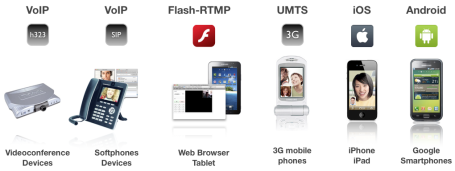
Video Channels:
- Video h323 Channel
- Video SIP Channel
- Video Flash/RTMP Server Channel
- Video 3G-324m TDM Channel
- Video Mobile Apps iOS/Android (over RTMP)
1. Video h323 – VoIP
H.323 call signaling is based on the ITU-T Recommendation Q.931 protocol and is suited for transmitting calls across networks using a mixture of IP, PSTN, ISDN, and QSIG over ISDN. A call model, similar to the ISDN call model, eases the introduction of IP telephony into existing networks of ISDN-based PBX systems, including transitions to IP-based PBXs.
Key Facts:
- Standard based VoIP protocol
- Most hardware conferencing solutions runs h323
- No evolution
Usage:
- To connect some specific video-conferencing or video-phone devices
Trend:
- Today, h323 is an old protocol not easy to configure and to manage. Keep this protocol only for specific devices you have to connect to your IVVR. Try to select SIP, if your device support it for a better service evolution.
2. Video SIP – VoIP
The Session Initiation Protocol (SIP) is an IETF-defined signaling protocol widely used for controlling communication sessions such as voice and video calls over Internet Protocol (IP). The protocol can be used for creating, modifying and terminating two-party (unicast) or multiparty (multicast) sessions consisting of one or several media streams.
Key Facts:
- Large number of VoIP devices and softphones (+)
- Flexible signaling protocol well (+)
- Very few video softphones are available for mobiles devices (-)
Usage:
- To connect video-conferencing or video-phone devices or video-SIP trunks
Trend:
- Any new VoIP device is supporting SIP, it’s the standard protocol for voice and video over IP communications. You cannot avoid SIP to connect your service thru trunks.
3. Video 3G-324m – TDM
The 3G-324M protocol operates over an established circuit switched connection between two communicating peers. 3G-324M is an umbrella specification to enable conversational multimedia communication over Circuit Switched (CS) networks and has been adopted by the 3GPP. 3G-324M is based on the ITU-T H.324 specification for multimedia conferencing over Circuit switched networks.
Key Facts:
- No app. installation required in your mobile phone (+)
- Interoperable thru UMTS network (+)
- Low screen size QCIF and poor video quality limited to 64kbps (-)
Usage:
- To make video calls over the UMTS wireless networks from any 3G videocall compliant mobile phone.
Trend:
- Available in most countries with UMTS networks but wireless carriers haven’t promote enough 3G videocalls and there’s very few services applications available in the market. Anyway, it’s the faster option to make a videocall and make it interoperable for 3G mobiles.
4. Video Flash/RTMP – IP
Real Time Messaging Protocol (RTMP) was initially a proprietary protocol developed by Macromedia for streaming audio, video and data over the Internet, between a Flash player and a server. Macromedia is now owned by Adobe, which has released the specification of the protocol for public use. Flash/RTMP is present in web browsers on 99% of the world’s computers.
Key Facts:
- Flexible bandwidth consumption management for QOS (+)
- Any size QCIF, CIF… HD and video quality available (+)
- Flash dependent, you need a Flash player (-)
Usage:
- To make voice or video calls over any web browser (flash enabled) or any OS.
Trend:
- Any device with a browser will work, this is 99,99% Windows, Mac or Linux computers and most Android Nebooks, Tablets or Smartphones. This solution runs without any addon or executable application.
5. Video iOS /Android – IP (over RTMP)
An iOS or Android mobile application can make videocalls and can be easily customized for many services. This option will allow any iPhone/iPad or Android device to make a call to a video contact center. Your own native mobile application can transcode RTMP format and connect to a remote VXI* server running the Flash/RTMP server channel. No Flash Player is required.
Key Facts:
- You have to install an application in your mobile phone (+)
- Service oriented, each service could use it’s own videophone app. (+)
- No interoperable with other IP telephony services (-)
Usage:
- To make voice or video calls over Internet from iPhone, iPad or Android smartphones.
Trend:
- Mandatory option for any video service for iOS and Android smartphones
Thank you for your continuous support!